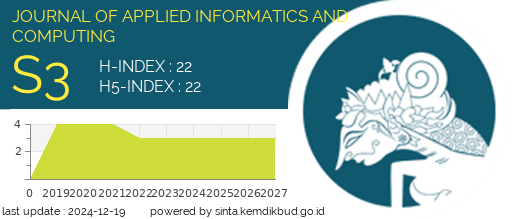Comparative Performance Analysis of GRPC and Rest API Under Various Traffic Conditions and Data Sizes Using a Quantitative Approach
DOI:
https://doi.org/10.30871/jaic.v9i2.9276Keywords:
gRPC, REST API, Web 3.0, Quantitative Analysis, HTTP/2Abstract
Web 3.0 presents challenges in efficient data exchange, especially in decentralized systems. REST API (HTTP/1.1) remains widely used due to its broad compatibility but has communication inefficiencies, while gRPC (HTTP/2) offers better performance with multiplexing and Protocol Buffers. This study compares REST API and gRPC under various traffic conditions and data sizes using Apache JMeter and Wireshark, measuring throughput, response time, latency, and data transfer efficiency. Results show that REST API has higher throughput in low-traffic scenarios (995 vs. 29.5 req/min) and faster GET response time (3 ms vs. 20 ms), while gRPC excels in large data transfers (276.34 KB/s vs. 134.1 KB/s) and stable latency (0.147 ms). However, ANOVA analysis (p > 0.05) indicates no statistically significant difference. REST API is ideal for standard web applications, while gRPC is suited for microservices and real-time systems.
Downloads
References
[1] H. F. Herdiyatmoko, “Back-End System Design Based on Rest Api,” J. Tek. Inf. dan Komput., vol. 5, no. 1, p. 123, 2022, doi: 10.37600/tekinkom.v5i1.401.
[2] P. L. Azzahra and A. Salam, “Desentralisasi dalam Perspektif Technology Trend terhadap Blockchain dan Web3,” J. Digit. Technol. Trend, vol. 2, no. 1, pp. 34–42, 2023, doi: 10.56347/jdtt.v2i1.149.
[3] E. D. Demircioğlu and O. Kalipsiz, “API Message-Driven Regression Testing Framework,” Electron., vol. 11, no. 17, 2022, doi: 10.3390/electronics11172671.
[4] B. Marii and I. Zholubak, “ADVANCES IN CYBER-PHYSICAL SYSTEMS,” vol. 7, 2022.
[5] M. I. Yanuardi, A. Aminudin, and M. Faiqurahman, “Analisis Perbandingan Efektivitas Arsitektur Restful dan Arsitektur Grpc pada Implementasi Web Service,” J. Edukasi dan Penelit. Inform., vol. 10, no. 2, p. 333, 2024, doi: 10.26418/jp.v10i2.80845.
[6] B. Shafabakhsh, R. Lagerström, and S. Hacks, “Evaluating the impact of inter process communication in microservice architectures,” CEUR Workshop Proc., vol. 2767, no. QuASoQ, pp. 55–63, 2020.
[7] K. S. M. Hari and R. Sharma, “Comparative Study of Orchestration Using Grpc Api and Rest Api in Server Creation Time: an Openstack Case,” Int. J. Comput. Networks Commun., vol. 16, no. 1, pp. 87–104, 2024, doi: 10.5121/ijcnc.2024.16106.
[8] F. Hanif, I. Ahmad, D. Darwis, I. Lazuardi Putra, and M. Fauzan Ramadhani, “Analisa Perbandingan Metode Graphql Api Dan Rest Api Dengan Menggunakan Asp.Net Core Web Api Framework,” J. Telemat. Inf., vol. 3, no. 2, pp. 2774–5384, 2022.
[9] A. Niklasson and V. Werèlius, “RESTful API vs. GraphQL a CRUD performance comparison,” p. 40, 2023.
[10] M. Johansson and O. Isabella, “Comparative Study of REST and gRPC for Microservices in Established Software Architectures,” 2023, [Online]. Available: https://urn.kb.se/resolve?urn=urn:nbn:se:liu:diva-195563
[11] E. Nilsson and D. Demir, “Performance comparison of REST vs GraphQL in different web environments : Node.js and Python,” p. 29, 2023.
[12] M. Śliwa and B. Pańczyk, “Performance comparison of programming interfaces on the example of REST API, GraphQL and gRPC,” J. Comput. Sci. Inst., vol. 21, no. October, pp. 356–361, 2021, doi: 10.35784/jcsi.2744.
[13] P. Diantono, A. Susanto, A. R. Supriyono, and D. N. Prasetyanti, “Perbandingan Kinerja Antara Gatling dan Apache JMeter pada Uji Beban RESTful API,” vol. 15, no. 01, pp. 211–215, 2024, doi: 10.35970/infotekmesin.v15i1.2176.
[14] M. Zaenul Hasan Basri and M. Zaenul Hasan, “Analysis and Security Testing for GRPC,” no. January, pp. 2020–2023, 2024, [Online]. Available: https://www.researchgate.net/publication/377360768
[15] Rangga Gelar Guntara and V. Azkarin, “Implementasi dan Pengujian REST API Sistem Reservasi Ruang Rapat dengan Metode Black Box Testing,” J. Minfo Polgan, vol. 12, no. 1, pp. 1229–1238, 2023, doi: 10.33395/jmp.v12i1.12691.
[16] B. Sutara and S. Gunawan, “Comparative Analysis of Rest Api Performance Between Express.Js Framework and Hapi.Js Using Apache Jmeter,” J. Ris. Tek. Inform., vol. 1, no. 1, pp. 19–26, 2024.
[17] B. A. Thango, “Application of the Analysis of Variance (ANOVA) in the Interpretation of Power Transformer Faults,” Energies, vol. 15, no. 19, 2022, doi: 10.3390/en15197224.
[18] V. Mandailina, D. Pramita, Syaharyddin, Ibrahim, Nurmiwati, and Abdillah, “Uji hipotesis menggunakan software jasp sebagai upaya peningkatan kemampuan teknik analisa data pada riset mahasiswa,” J. Character Educ. Soc., vol. 5, no. 2, pp. 512–519, 2022, [Online]. Available: http://journal.ummat.ac.id/index.php/JCEShttps://doi.org/10.31764/jces.v5i2.6109https://doi.org/10.31764/jces.v3i1.XXX
[19] G. Jain and Anubha, “Application of SNORT and Wireshark in Network Traffic Analysis,” IOP Conf. Ser. Mater. Sci. Eng., vol. 1119, no. 1, p. 012007, 2021, doi: 10.1088/1757-899x/1119/1/012007.
[20] Yeni Setiani, Nabila Rachmah, and Indra Purnama, “Visualisasi Data Malnutrisi Anak Di Asia Menggunakan Looker Studio Serta Analisis Data Dengan Metode ANOVA,” J. Ilm. Sist. Inf. dan Ilmu Komput., vol. 3, no. 3, pp. 188–212, 2023, doi: 10.55606/juisik.v3i3.701.
Downloads
Published
How to Cite
Issue
Section
License
Copyright (c) 2025 Moch. Zukhruf Ain, Rizka Ardiansyah, Septiano Anggun Pratama, Muhammad Akbar, Nouval Trezandy Lapatta

This work is licensed under a Creative Commons Attribution-ShareAlike 4.0 International License.
Authors who publish with this journal agree to the following terms:
- Authors retain copyright and grant the journal right of first publication with the work simultaneously licensed under a Creative Commons Attribution License (Attribution-ShareAlike 4.0 International (CC BY-SA 4.0) ) that allows others to share the work with an acknowledgement of the work's authorship and initial publication in this journal.
- Authors are able to enter into separate, additional contractual arrangements for the non-exclusive distribution of the journal's published version of the work (e.g., post it to an institutional repository or publish it in a book), with an acknowledgement of its initial publication in this journal.
- Authors are permitted and encouraged to post their work online (e.g., in institutional repositories or on their website) prior to and during the submission process, as it can lead to productive exchanges, as well as earlier and greater citation of published work (See The Effect of Open Access).











